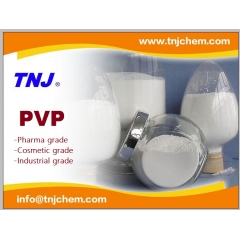Chitosan (CAS 9012-76-4) is is a linear polysaccharide composed of  randomly distributed β-(1-4)-linked D-glucosamine (deacetylated unit) and N-acetyl-D-glucosamine (acetylated unit). It is made by treating shrimp and other crustacean shells with an alkaline substance, like sodium hydroxide.
randomly distributed β-(1-4)-linked D-glucosamine (deacetylated unit) and N-acetyl-D-glucosamine (acetylated unit). It is made by treating shrimp and other crustacean shells with an alkaline substance, like sodium hydroxide.
Chitosan has a number of commercial and possible biomedical uses. It can be used in agriculture as a seed treatment and biopesticide, helping plants to fight off fungal infections. In winemaking it can be used as a fining agent, also helping to prevent spoilage. In industry, it can be used in a self-healing polyurethane paint coating. In medicine, it may be useful in bandages to reduce bleeding and as an antibacterial agent; it can also be used to help deliver drugs through the skin.More controversially, chitosan has been asserted to have use in limiting fat absorption, which would make it useful for dieting, but there is evidence against this.Other uses of chitosan that have been researched include use as a soluble dietary fiber.
Molecula weight
mol wt 190000-310000 Da
mol wt 50000-190000 Da (based on viscosity)
Viscosity
20-300 cP, 1 wt. % in 1% acetic acid (25Co, Brookfield)(lit.)
Specification
Appearance Light to white powder
Moisture 8.0%max
Ash 1.0%max
DAC degree 90%~95%min
Bulk density 0.27mg/ml min
Particle size 95%min though 80mesh
Application
Food preservative
In the food industry, chitosan is a natural, non-toxic preservative, flocculant, and can adsorb cadmium, mercury, copper and other heavy metal ions from water;Agricultural and horticultural use
The agricultural and horticultural uses for chitosan, primarily for plant defense and yield increase, are based on how this glucosamine polymer influences the biochemistry and molecular biology of the plant cell.
Water filtration
Chitosan can also be used in water processing engineering as a part of a filtration process. Chitosan causes the fine sediment particles to bind together, and is subsequently removed with the sediment during sand filtration. It also removes phosphorus, heavy minerals, and oils from the water. Chitosan is an important additive in the filtration process.
Winemaking and fungal source chitosan
Chitosan has a long history for use as a fining agent in winemaking. Fungal source chitosan has shown an increase in settling activity, reduction of oxidized polyphenolics in juice and wine, chelation and removal of copper (post-racking) and control of the spoilage yeast Brettanomyces.
Cosmetic field
Applicable to various cosmetics, such as emollient cream, shower gel, cleaning cream, mousse, advanced ointment frost,
emulsion and colloid cosmetics, etc.
Potential industrial usesScientists have developed a polyurethane coating that heals its own scratches when exposed to sunlight. The self-healing coating uses chitosan incorporated into traditional polymer materials, such as those used in coatings on cars to protect paint.
Packaging
25kg/fiber drum
12mt(480drum)/20"FCL without pallets
7mt(280drum)/20"FCL with pallets







 TDS Chitosan.pdf
TDS Chitosan.pdf







 chemical.tnj
chemical.tnj +8618949823763
+8618949823763 tnjchem
tnjchem 2881500864
2881500864